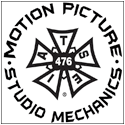
Canadian playwright Danny Schur’s musical, Strike!, was doing just fine until film director Robert Adetuyi got his hands on it. An up-tempo depiction of a love story that takes place during the 1919 Winnipeg General Strike, the award-winning performance had established itself as a Canadian favorite after premiering in 2005.
Now, Strike! has been turned into a movie called Stand! that makes its US premiere at the JCC Chicago Jewish Film Festival on Friday. Think Hamilton meets Fiddler on the Roof meets West Side Story in a movie that, according to its creators, is perfect for Chicago.
The story is woven into a history lesson about a labor strike that began when 30,000 workers walked off their jobs in Winnipeg in 1919 and ended a month later, when mounted police rushed into a throng of strikers, injuring 30 and killing two.
ALSO READ: JCC Chicago Jewish Film Festival unveils 2020 lineup
“A great movie”
Schur’s theatrical interpretation of the strike was an immediate success back in 2005. It attracted fans like Jeff Goldblum, who saw one of the early performances and exclaimed that, “it would make a great movie.”
For the film version, he tapped Adetuyi, a native Canadian who had relocated to L.A. and built a strong reputation for musical films like Bring It On: Worldwide #Cheersmack.
After viewing a videotape of the performance, Adetuyi recalls feeling “immediately” drawn to the labor story; but he also felt that it required a facelift before making an appearance on screen.
“I wanted to come at it with a more grounded approach that was closer to Les Mis,” he explains. “Also — and not because I’m a Black filmmaker — I said, ‘let’s get more diversity in this story.’”
That’s when Strike! began its transformation into Stand!, a film directed by Adetuyi and co-written by Schur and Rick Chafe. Here in a Reel Chicago exclusive, Schur and Adetuyi recount their journey to the screen.
‘Stand!’ premieres Friday March 6 at the Century 12 Evanston/CineArts 6 as part of the JCC Chicago Jewish Film Festival. For more information, click on this
To learn more about the JCC Chicago Jewish Film Festival, click here.
What was the original inspiration and logline for Stand?
Danny Schur: The inspiration for a proper movie adaptation of the stage show was Jeff Goldblum, in 2005, pounding me on the chest and saying, ‘I like this! I like this!’ He is six-four, six-five. He said, ‘Dan, big story, big ideas, it would make a great movie.’
Robert Adetuyi: Originally, Dan and Rick wrote it as a musical stage show. It was a much lighter show that had 18 songs, what I call an up-tempo kind of version. It was tackling issues like immigration, labor rights, and how the powers that be were trying to exploit and divide and conquer the immigrant groups in the city at the time, and how a Romeo and Juliet come together and become lovers even though their families have opposite views of whether or not there should be a general strike.
They wrote the play into a movie and got it to my agent because I’m known for musically-driven work. I immediately identified with the labor story, because I come from a small labor town. My father’s from Nigeria and my mother’s from Germany, and they met in a mining town called Sudbury, Ontario.
When I read the script and saw a videotape of the stage show, two things hit me: I wanted to come at it with a more grounded approach that was closer to Les Mis. There were dark issues here. Also, and not because I’m a Black filmmaker, I said, ‘let’s get more diversity in this story.’ All the characters were white. I knew there were a lot of people of color in Winnipeg and a lot of indigenous people. So we turned the play’s Irish woman into an African-American woman fleeing Oklahoma. There was a lot of persecution of Black folks there.
The kicker to that character was that we needed to give her a really powerful song, so Danny wrote Stand, which became the title.
The lead character of the original was a soldier returning from World War I, who was an Irish Canadian. We really contemporized the flavor. When you hear the song Stand, you think Black Lives Matter and other themes that resonate right now. That’s what I was looking for as a filmmaker: how to make a movie set in 1919 relevant today. The play Hamilton really inspired people to take a historical story and make it hip and relevant now, and when I read the script for Stand!, it was like, wow, these issues sound like US headlines right now.
What are viewers going to learn about Canada by watching Stand!?
DS: It’s not the progressive utopia of common perception. I think we safely burst that balloon. Nationalism aside, I like to say that times change and people don’t. We’d be fools to assume there isn’t racism and suppression of rights in Canada. It still happens.
I’m a huge believer in the universal depiction of mankind in film. You could watch this and know it was 1919, but not be sure if it was the US or Canada, except for the fact that we mention a king. Most people say, ‘my God, I did not know this has happened or could happen in Canada.’
One of our first screenings was literally yards from the White House in DC. People were coming up to us. Tears were streaming down their faces. And they said, ‘my God, your story is our story. America needs this movie right now.’ That is the single greatest compliment I’ve received. You always think your story might be provincial, but it’s great to hear when it’s not.
RA: I’ve become Americanized. For a long time, I was talking about Canada as the land of Utopia. Working on this project really brought me back to the realities of Canada. What we’re all saying here is true, but, contemporarily, I have discovered there is more racism in Canada in the workplace than there is said to be in the US.
Take the story of Emma’s people coming up from Oklahoma to find refuge in Canada. At the time, the Canadian government sought to ban them by saying things like, ‘well they won’t like our weather.’
My friends in the States kept thinking I was working on an American movie, and you go, ‘no this is really what’s going on in Canada.’ One thing they really appreciate is that this movie got funding from the Canadian government and all that.
In LA, they say it would be hard to get this movie made here. It’s very critical of the government as well as the private business people in Winnipeg who are the ancestors of the original oppressors. To move forward, you have to face the issues. That’s why Americans like it so much.
 DS: An early conversation that I had with an investor was indicative of our challenge. I called a certain gentleman saying we were looking for some cash to create a new musical set against the 1919 Labor Strike.
DS: An early conversation that I had with an investor was indicative of our challenge. I called a certain gentleman saying we were looking for some cash to create a new musical set against the 1919 Labor Strike.
He said, ‘I’m going to stop you right there: do you have any idea who I am?’
I said, ‘yep, your grandfather was right there (on the business side of the labor confrontation).
He said, ‘this is nothing that we should celebrate or commemorate. It is a stain on the city. We should end the conversation right there.’
‘But you didn’t even listen to the music,’ I tole him. ‘Stuff is different as a musical. I’m not trying to suggest that you are at fault for being related to the people involved in the original incident.’
Less than a week later, my phone rings, and I see it’s him and I have utter dread and he says this is the sound of me taking my foot out of my mouth. Where do I send the check?
He also gave me a list of people to contact and told me to use his name. Every single person on it was some sort of conversation of that sort. Until pretty much 2000, the General Strike was so shrouded in infamy that no one really wanted to talk about it.
What were the challenges and rewards of turning a musical into a film?
RA: I think it comes back to what kind of musical you want to make. I wanted something more grounded. In the stage play, there were a lot of dancing and broader numbers. I would listen to the lyrics of the song and imagine how would this be dramatically told. The dialogue plays very strong when you take what they were singing and make them say it.
We treated the songs a little more dramatically. They don’t move from talking and suddenly become a Broadway musical number. I love Broadway musicals — don’t want to look like I’m down on that — but we kept the songs that expressed the emotions. This one has eight.
For the opening number, a character is writing a letter in Canada to his wife back in Ukraine, and then he goes and starts singing his feelings. There is also a maid named Emma who works in the home of a wealthy businessman and becomes one of the strike organizers. She is portrayed by Lisa Bell, who is the next Jennifer Hudson. She belts out these four songs like no one else can do.
We also had a budget to deal with. How do we do the recreation of 1919? We have a Winnipeg a neighborhood that really has the look of 1919.
What makes Chicago a great city for the US Premiere?
DS: Winnipeg is the Chicago of the North. If you know Chicago, you know a Winnipeg, except it’s miniaturized. The events of 1919 in Winnipeg were so similar to what happened in Chicago that I believe Winnepeg’s story is Chicago’s story. I can’t think of a more parallel universe. Over and over the similarities are borne out. There are more than 100 buildings in Winnipeg designed by John D. Atchison (a prominent member of the “Chicago School” of architects).
Also, this story has a lot in common withFiddler on the Roof, which is a great depiction of a Ukrainian shtetl. Near the end of the story, one of the characters says he’s going to Chicago. Many members of Chicago’s Jewish community are descended from people who came directly to the city after the last pogrom in Ukraine in 1919. My family came to Winnipeg, which has the second-largest population of Ukrainian immigrants.
RA: For whatever reason, the Chicago Blackhawks were my favorite hockey team when I was growing up in Sudbury. I always had this strong affinity for Chicago. When I thought of America, I thought of Chicago first. The first Black president of the US came from Chicago. There is a legend and mystique of Chicago that I really love.

















